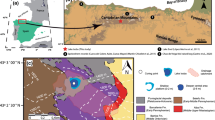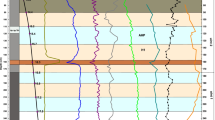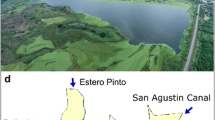Abstract
Lacustrine sediments in north-eastern Germany have rarely been used as archives to address the effects of climate change and human impact on both lake ecosystem and landscape evolution for this region. Sacrower See, a hardwater lake located in Brandenburg, provides a unique sediment record covering the past 13,000 years which was used to reconstruct climatic and anthropogenic forcing on lacustrine sedimentation. Time control is provided by 12 AMS 14C dates of terrestrial plant remains, the Laacher See Tephra, and the onset of varve formation in AD 1870 (80 cal. BP). Geochemical (including XRF logging of major elements, CNS analyses as well as δ13Corg and δ15N measurements) and pollen analyses allowed detecting detailed environmental changes in the sediment record. During the Younger Dryas cold phase increased soil erosion and hypolimnetic oxygen depletion enhanced the nutrient supply to the lake water causing eutrophic conditions. The beginning of the Holocene is characterized by large changes in C/N ratios, total sulphur, δ13C of bulk organic matter as well as in K, Si, and Ti, reflecting the response of the lake’s catchment to climatic warming. Reforestation reduced the influx of detrital particles and terrestrial organic matter. The first, rather weak evidence of human impact is documented only in the pollen record at 5,500 cal. BP. However, until 3,200 cal. BP sedimentological and geochemical parameters indicate relatively stable environmental conditions. During periods of intense human impact at around 3,200, 2,800, and 900 cal. BP peaks in Ti and K represent phases of increased soil erosion due to forest clearing during the Bronze Age, Iron Age, and Medieval Times, respectively. In general, greater variation is observed in most variables during these perturbations, indicating less stable environmental conditions. The steady rise of biogenic silica accumulation rates during the Holocene reflects an increasing productivity of Sacrower See until diatoms were outcompeted by other algae during the last centuries. The applied multi-proxy approach fosters the interpretation of the sediment record to reveal a consistent picture of environmental change including environmental factors controlling lake ontogeny and the effects of human impact.







Similar content being viewed by others
References
Alley RB, Mayewski PA, Sowers T, Stuiver M, Taylor KC, Clark PU (1997) Holocene climatic instability: a prominent, widespread event 8200 year ago. Geology 25:483–486
Babiel K et al (2000) Potsdam, Brandenburg und das Havelland, Führer zu archäologischen Denkmälern in Deutschland, Band 37. Theiss, Stuttgart, 286 pp
Bennett KD (1986) Coherent slumping of early postglacial lake sediments at Hall Lake, Ontario, Canada. Boreas 15:209–215
Bennett KD (1996) Determination of the number of zones in a biostratigraphical sequence. New Phytol 132:155–170
Birks HJB, Gordon AD (1985) Numerical methods in quaternary pollen analysis. Academic Press, London 317 pp
Bluszcz P, Kirilova E, Lotter AF, Ohlendorf C, Zolitschka B (2008) Global radiation and onset of stratification as forcing factors of seasonal carbonate and organic matter flux dynamics in a hypertrophic hardwater lake (Sacrower See, Northeastern Germany). Aquat Geochem 14:73–98
Bluszcz P, Lücke A, Ohlendorf C, Zolitschka B (2009) Seasonal dynamics of stable isotopes and element ratios in authigenic calcites during their precipitation and dissolution, Sacrower See (northeastern Germany). Journal of Limnology 68:257–273
Böse M, Brande A (2000) Regional patterns of Holocene sand transport in the Berlin-Brandenburg area. In: Dulias R, Pełka-Gościniak J (eds) Aeolian processes in different landscape zones. The Association of Polish Geomorphologists, Sosnowiec, pp 51–58
Brande A, Böse M, Müller M, Facklam M, Wolters S (1999) The Bliesendorf soil and aeolian sand transport in the Potsdam area. In: Schirmer W (ed) Dunes and fossil soils. Lit-Verlag, Münster, pp 147–161
Brauer A, Endres C, Günter C, Litt T, Stebich M, Negendank JFW (1999) High resolution sediment and vegetation responses to Younger Dryas climate change in varved lake sediments from Meerfelder Maar, Germany. Quaternary Sci Rev 18:321–329
Bronk Ramsey C (2001) Development of the radiocarbon program OxCal. Radiocarbon 43:355–363
Burke IC, Kemp AES (2002) Microfabric analysis of Mn-carbonate laminae deposition and Mn-sulfide formation in the Gotland Deep, Baltic Sea. Geochim Cosmochim Ac 66:1589–1600
de Boer WM (1995) Äolische Prozesse und Landschaftsformen im mittleren Baruther Urstromtal seit dem Hochglazial der Weichselkaltzeit. Fachbereich Geographie der Humboldt-Universität Berlin, Berlin 215 pp
Dinh LX (2008) Long-term development of nutrient loads in Berlin surface water system and their causes during the last 150 years. Department of Earth Sciences. Freie Universität Berlin, Berlin, 198 pp
Dreßler M, Selig U, Dörfler W, Adler S, Schubert H, Hübener T (2006) Environmental changes and the migration period in northern Germany as reflected in the sediments of Lake Dudinghausen. Quaternary Res 66:25–37
Ehleringer JR, Cerling TE, Helliker BR (1997) C4 photosynthesis, atmospheric CO2, and climate. Oecologia 112:285–299
Emmer E, Thunell RC (2000) Nitrogen isotope variations in Santa Barbara Basin sediments: implications for denitrification in the eastern tropical North Pacific during the last 50,000 years. Paleoceanography 15:377–387
Enters D, Lücke A, Zolitschka B (2006) Effects of land-use change on deposition and composition of organic matter in Frickenhauser See, northern Bavaria, Germany. The Sci Tot Environ 369:178–187
Enters D, Dörfler W, Zolitschka B (2008) Historical soil erosion and land-use change during the last two millennia recorded in lake sediments of Frickenhauser See, northern Bavaria, central Germany. Holocene 18:243–254
Fisher E, Oldfield F, Wake R, Boyle J, Appleby P, Wolff GA (2003) Molecular marker records of land use change. Org Geochem 34:105–119
Fritz SC (2008) Deciphering climatic history from lake sediments. J Paleolimnol 39:5–16
Harvey HR, Tuttle JH, Bell JT (1995) Kinetics of phytoplankton decay during simulated sedimentation: changes in biochemical composition and microbial activity under oxic and anoxic conditions. Geochim Cosmochim Ac 59:3367–3377
Heegaard E, Birks HJB, Telford RJ (2005) Relationships between calibrated ages and depth in stratigraphical sequences: an estimation procedure by mixed-effect regression. Holocene 15:612–618
Hodell DA, Schelske CL (1998) Production, sedimentation, and isotopic composition of organic matter in Lake Ontario. Limnol Oceanogr 43:200–214
Jahns S (2007) Palynological investigations into the Late Pleistocene and Holocene history of vegetation and settlement at the Löddigsee, Mecklenburg, Germany. Veg Hist Archaebot 16:157–169
Jansen JHF, van der Gaast SJ, Koster B, Vaars AJ (1998) CORTEX, a shipboard XRF-scanner for element analyses in split sediment cores. Mar Geol 151:143–153
Kaiser K, Rother H, Lorenz S, Gärtner P, Papenroth R (2007) Geomorphic evolution of small river–lake-systems in northeast Germany during the Late Quaternary. Earth Surf Proc Land 32:1516–1532
Kirilova E, Heiri O, Enters D, Cremer H, Lotter AF, Zolitschka B, Hübener T (2009) Climate-induced changes in the trophic status of a Central European lake. J Limnol 68:71–82
Lotter AF (2001) The palaeolimnology of Soppensee (Central Switzerland), as evidenced by diatom, pollen, and fossil-pigment analyses. J Paleolimnol 25:65–79
Lotter AF, Juggins S (1991) POLPROF, TRAN and ZONE: programs for plotting, editing and zoning pollen and diatom data. INQUA-subcommission for the study of the Holocene working group on data-handling methods newsletter 6:4–6
Lücke A, Brauer A (2004) Biogeochemical and micro-facial fingerprints of ecosystem response to rapid Late Glacial climatic changes in varved sediments of Meerfelder Maar (Germany). Palaeogeogr Palaeoclimatol Palaeoecol 211:139–155
Lücke A, Schleser GH, Zolitschka B, Negendank JFW (2003) A Lateglacial and Holocene organic carbon isotope record of lacustrine palaeoproductivity and climatic change derived from varved lake sediments of Lake Holzmaar, Germany. Quaternary Sci Rev 22:569–580
Lüder B, Kirchner G, Lücke A, Zolitschka B (2006) Palaeoenvironmental reconstructions based on geochemical parameters from annually laminated sediments of Sacrower See (northeastern Germany) since the 17th century. J Paleolimnol 35:897–912
Moore PD, Webb JA, Collinson ME (1991) Pollen analysis. Blackwell Scientific Publications, Oxford 216 pp
Müller PJ, Schneider R (1993) An automated leaching method for the determination of opal in sediments and particulate matter. Deep-Sea Res 40:425–444
Müller B, Wang Y, Dittrich M, Wehrli B (2003) Influence of organic carbon decomposition on calcite dissolution in surficial sediments of a freshwater lake. Water Res 37:4524–4532
Olsson S, Regnéll J, Persson A, Sandgren P (1997) Sediment-chemistry response to land-use change and pollutant loading in a hypertrophic lake, southern Sweden. J Paleolimnol 17:275–294
Pachur H-J, Röper H-P (1987) Zur Paläolimnologie Berliner Seen. Berliner Geographische Abhandlungen, vol 44. Berlin, 150 pp
Pachur H-J, Röper H-P (1990) Die Evolution der Berliner Seen und geoökologische Konsequenzen. Berliner Geographische Abhandlungen 53:159–173
Polley HW, Johnson HB, Marino BD, Mayeux HS (1993) Increase in C3 plant water-use efficiency and biomass over glacial to present CO2 concentrations. Nature 361:61–64
Ramisch F, Dittrich M, Mattenberger C, Wehrli B, Wüest A (1999) Calcite dissolution in two deep eutrophic lakes. Geochim Cosmochim Acta 63:3349–3356
Reimer PJ, Baillie MGL, Bard E, Bayliss A, Beck JW, Bertrand CJH, Blackwell PG, Buck CE, Burr GS, Cutler KB, Damon PE, Edwards RL, Fairbanks RG, Friedrich M, Guilderson TP, Hogg AG, Hughen KA, Kromer B, McCormac G, Manning S, Ramsey CB, Reimer RW, Remmele S, Southon JR, Stuiver M, Talamo S, Taylor FW, van der Plicht J, Weyhenmeyer CE (2004) IntCal04 terrestrial radiocarbon age calibration, 0–26 cal Kyr BP. Radiocarbon 46:1029–1058
Rümmler F, Schiewe S, Ebel H (1997) Arbeitsbericht 1997 zur wissenschaftlichen Begleitung der Sanierung des Sacrower Sees mittels Tiefenwasserbelüftung. Institut für Binnenfischerei e.V., Potsdam, 35 pp
Schaller T, Moor HC, Wehrli B (1997) Sedimentary profiles of Fe, Mn, V, Cr, As and Mo as indicators of benthic redox conditions in Baldeggersee. Aquat Sci 59:345–361
Schmidt R, Psenner R, Müller J, Indinger P, Kamenik C (2002) Impact of late glacial climate variations on stratification and trophic state of the meromictic lake Längsee (Austria): validation of a conceptual model by multi proxy studies. J Limnol 61:49–60
Schmidtchen G, Bork H-R (2003) Changing human impact during the period of agriculture in central Europe: the case study Biesdorfer Kehlen, Brandenburg, Germany. In: Lang A, Hennrich K, Dikau R (eds) Lecture Notes in Earth Sciences. Springer, Berlin, pp 183–200
Schmincke H-U (2004) Volcanism. Springer, Berlin, p 324
Schroeder JH (ed) (2001) Geologie von Berlin und Brandenburg. Nr. 4: Potsdam und Umgebung. Selbstverlag Geowissenschaftler in Berlin und Brandenburg e.V., Berlin, 277 pp
Selig U, Leipe T, Dörfler W (2007) Paleolimnological records of nutrient and metal profiles in prehistoric, historic and modern sediments of three lakes in North-eastern Germany. Water Air Soil Poll 184:183–194
Sigg L, Stumm W (1996) Aquatische Chemie. Teubner, Stuttgart, 498 pp
Steinberg C (1983) Effects of artificial destratification on the phytoplankton populations in a small lake. J Plankton Res 4:855–864
Stevens RE, Hedges REM (2004) Carbon and nitrogen stable isotope analysis of northwest European horse bone and tooth collagen, 40, 000 BP-present: palaeoclimatic interpretations. Quaternary Sci Rev 23:977–991
Talbot MR (2001) Nitrogen isotopes in palaeolimnology. In: Last WM, Smol JP (eds) Tracking environmental change using lake sediments. Kluwer, Dordrecht, pp 401–439
Teranes JL, Bernasconi S (2000) The record of nitrate utilization and productivity limitation provided by δ15N values in lake organic matter—a study of sediment trap and core sediments from Baldeggersee, Switzerland. Limnol Oceanogr 45:801–813
van Geel B, Bokovenko NA, Burova ND, Chugunov KV, Dergachev VA, Dirksen VG, Kulkova M, Nagler A, Parzinger H, Plicht Jvd, Vasiliev SS, Zaitseva GI (2004) Climate change and the expansion of the Scythian culture after 850 BC: a hypothesis. J Archaeol Sci 31:1735–1742
von Grafenstein U, Erlenkeuser H, Müller J, Jouzel J, Johnsen S (1998) The cold event 8200 years ago documented in oxygen isotope records of precipitation in Europe and Greenland. Clim Dynam 14:73–81
Wolfe BB, Edwards TWD, Aravena R (1999) Changes in carbon and nitrogen cycling during tree-line retreat recorded in the isotopic content of lacustrine organic matter, western Taimyr Peninsula, Russia. Holocene 9:215–222
Wolters S (2002) Vegetationsgeschichtliche Untersuchungen zur spätglazialen und holozänen Landschaftsentwicklung in der Döberitzer Heide. J. Cramer, Berlin, 157 pp
Zolitschka B, Behre K-E, Schneider J (2003) Human and climatic impact on the environment as derived from colluvial, fluvial and lacustrine archives—examples from the Bronze age to the Migration period, Germany. Quaternary Sci Rev 22:81–100
Acknowledgments
We are very grateful to the other members of the coring team (Philipp Bluszcz, Britta Lüder and Christian Ohlendorf, all at GEOPOLAR, University of Bremen), for the support by Herbert Ebel, Uwe Brämick and Frank Rümmler (Institut für Binnenfischerei Potsdam) and to Benjamin Bünning, Sabine Stahl (GEOPOLAR) and Holger Wissel (Forschungszentrum Jülich) for help with the laboratory analyses. We also thank Thomas Frederichs and Christian Hilgenfeldt (Marine Geophysics, University of Bremen) for the use of the magnetic susceptibility logging device. Steve Juggins (Newcastle University) kindly provided a new version of ZONE capable for large datasets and Steffen Wolters (NIhK Wilhelmshaven) gave valuable information on the regional vegetation history. The manuscript was improved by the comments of Thomas Whitmore and two anonymous reviewers.
Author information
Authors and Affiliations
Corresponding author
Rights and permissions
About this article
Cite this article
Enters, D., Kirilova, E., Lotter, A.F. et al. Climate change and human impact at Sacrower See (NE Germany) during the past 13,000 years: a geochemical record. J Paleolimnol 43, 719–737 (2010). https://doi.org/10.1007/s10933-009-9362-3
Received:
Accepted:
Published:
Issue Date:
DOI: https://doi.org/10.1007/s10933-009-9362-3




